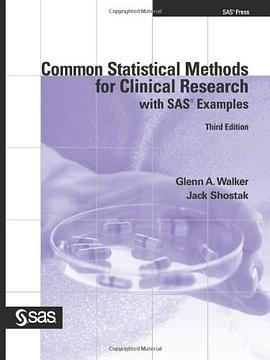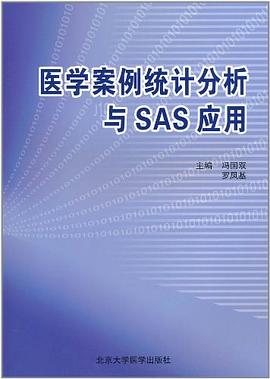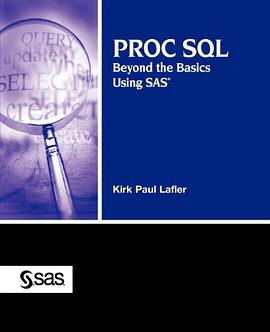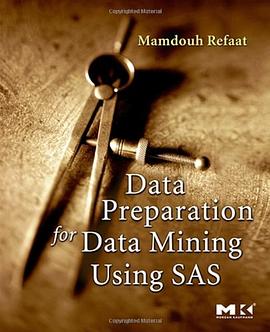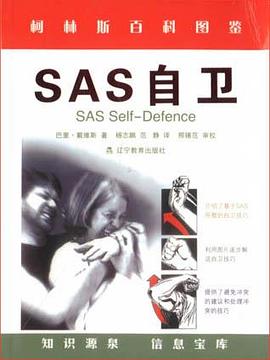
SAS Hash Object Programming Made Easy pdf epub mobi txt 电子书 下载 2025
- SAS
- 工具书
- 哈希表
- SAS
- Hash Object
- Programming
- Data Manipulation
- SAS Programming
- Data Structures
- Performance Tuning
- SAS Tips
- Data Analysis
- SAS Macro
- Data Processing

具体描述
Hash objects, an efficient look-up tool in the SAS DATA step, are object-oriented programming structures that function differently from traditional SAS language statements. Michele Burlew's SAS Hash Object Programming Made Easy shows readers how to use these powerful features, which they can program to quickly look up and manage data and to conserve computing resources. SAS provides various look-up techniques, and hash objects are among the newest, so therefore many users may not have yet used them. Because the examples presented vary in complexity, SAS Hash Object Programming Made Easy is useful to SAS users of all experience levels, from novice programmer to advanced programmer. Novice programmers can adapt some of the simpler hash programming techniques as they develop their SAS programming skills. This book helps more experienced programmers learn how to take advantage of hash object programming by comparing traditional processing techniques to those that use hash objects. Additionally, users from diverse fields with different requirements can adapt the examples in SAS Hash Object Programming Made Easy to fit their unique situations.
作者简介
Burlew, Michele M.
Michele M. Burlew, president of Episystems, Inc., designs and programs SAS applications for data management, data analysis, report writing, and graphics for academic and corporate clients. A SAS user since 1980, she has expertise in many SAS products and operating systems. Burlew is the author of six other SAS Press books: Combining and Modifying SAS Data Sets: Examples, Second Edition; Output Delivery System: The Basics and Beyond (coauthor); SAS Guide to Report Writing: Examples, Second Edition; SAS Macro Programming Made Easy, Second Edition; Debugging SAS Programs: A Handbook of Tools and Techniques; and Reading External Data Files Using SAS: Examples Handbook.
目录信息
About This Book...................................................................................... vii
About The Author ..................................................................................... xi
Acknowledgments.................................................................................. xiii
Preface ....................................................................................................xv
Chapter 1: An Overview of Hash Objects.................................................... 1
What Are Hash Objects? ............................................................................................................... 2
Introducing a Simple Hash Object Application........................................................................... 2
Chapter 2: Hash Object Terminology and Concepts ................................... 7
What Is a SAS Hash Object?......................................................................................................... 7
Defining Terms Associated with Hash Objects .......................................................................... 8
Writing Code That Works with Hash Objects.............................................................................. 9
Understanding How SAS Stores Hash Objects in Memory .....................................................10
Understanding How Long Hash Objects Persist......................................................................11
Specifying the Contents of Hash Objects..................................................................................11
Initializing Variables in a DATA Step That Contains a Hash Object........................................14
Illustrating How the Program Data Vector Connects DATA Step Variables
and Hash Object Items................................................................................................................15
Chapter 3: Basic Hash Object Applications..............................................25
Using a Hash Object As a Lookup Table...................................................................................26
Defining a Hash Object................................................................................................................26
Finding Key Values in a Hash Object.........................................................................................28
Defining the Key Structure in a Hash Object ............................................................................30
Understanding How the FIND and CHECK Methods Alter the Values of DATA Step
Variables and Hash Object Data Items......................................................................................30
Application Example: Verifying Presence of Key Values .........................................................33
Application Example: Returning Data Items from a Hash Object...........................................36
Application Example: Defining the Key Value During Processing of the DATA Step............39
Application Example: Searching for a Key Value in Multiple Hash Objects...........................41
Application Example: Combining Data from Multiple Sources...............................................44
Using Multiple Key Items to Look Up Data ...............................................................................49
Traversing Hash Objects.............................................................................................................53
Specifying a Hash Iterator Object..............................................................................................53
Understanding the Methods That Control Traversal of a Hash Object..................................54
Illustrating How the Hash Iterator Object Traverses a Hash Object......................................55
Application Example: Traversing a Hash Object from Beginning to End...............................59
Application Example: Linking Hierarchically Related Data Sets.............................................62
Application Example: Performing a Fuzzy Merge Using a Hash Iterator Object...................66
Chapter 4: Creating Data Sets from Hash Objects and Updating
Contents of Hash Objects.......................................................71
Creating a Data Set from a Hash Object...................................................................................72
Adding, Modifying, and Removing Data from a Hash Object..................................................73
Defining the Key Structure in a Hash Object ............................................................................74
Understanding How to Specify the KEY and DATA Argument Tags ......................................75
Identifying the Variables That the OUTPUT Method Writes to a Data Set.............................77
Understanding the Interaction between DATA Step Variables and Hash Object
Data Items When Replacing Data in a Hash Object................................................................. 78
Replacing Key Item Values When a Key Item Is Also a Data Item..........................................80
Comparing the DATA Statement and the OUTPUT Method....................................................83
Application Example: Finding the Unique Values of a Variable in a Data Set........................87
Application Example: Ordering Observations by Variables Not Saved to a Data Set
Created from a Hash Object.......................................................................................................90
Application Example: Using Hash Objects to Apply Transactions to
Master Data Sets—Part 1............................................................................................................92
Application Example: Using Hash Objects to Apply Transactions to
Master Data Sets—Part 2............................................................................................................97
Application Example: Summarizing Data with the Hash Iterator Object.............................102
Application Example: Summarizing Hierarchically Related Data .........................................106
Chapter 5: Hash Objects with Multiple Sets of Data Items per
Key Value.............................................................................113
Understanding the Concepts of Duplicate Key Values and Multiple Sets
of Data Items per Key Value in a Hash Object........................................................................114
Defining Hash Objects That Process Multiple Sets of Data Items per Key Value...............115
Illustrating How the MULTIDATA and DUPLICATE Argument Tags Affect Hash
Object Processing......................................................................................................................117
Understanding the Methods That Look for Multiple Sets of Data Items per Key ...............121
Understanding How SAS Stores Multiple Sets of Data Items per Key................................. 123
Comparing Retrieval of Data from a Hash Object That Allows Multiple
Sets of Data Items per Key Value to a Hash Iterator Object.................................................123
Modifying Data in a Hash Object That Allows Multiple Sets of Data Items per Key Value 129
Summarizing Data in Hash Objects That Allow Multiple Sets of Data Items per
Key Value ....................................................................................................................................143
Application Example: Summarizing and Sorting a Data Set..................................................144
Application Example: Creating Data Sets Based on a Series of Observations...................147
Application Example: Creating a Data Set That Contains All Combinations
of Specific Variables When the Number of Combinations Is Large......................................151
Application Example: Linking Hierarchically Related Data Using a Hash Object
That Allows Multiple Sets of Data Items per Key Value.........................................................154
Chapter 6: Managing Hash Objects........................................................159
Creating, Deleting, and Clearing Hash Objects During Execution of a DATA Step............159
Determining the Number of Items in a Hash Object ..............................................................164
Application Example: Creating a Data Set for Each BY Group.............................................166
Comparing Two Hash Objects..................................................................................................170
Specifying Memory Structure Usage of a Hash Object.........................................................174
Determining the Size of an Entry in a Hash Object................................................................174
Index.....................................................................................................181
· · · · · · (收起)
读后感
读这本书之前,至少要了解数据结构中的散列表是什么东西。推荐把算法导论那本书中散列表那章看看。 这本书的内容并不难,都能读懂,但是让我轻而易举的写出Hash风格的SAS代码,就要长期的勤加实践了。问题是我没那么多机会和时间,反正读这本书有种自娱自乐的感觉。
评分读这本书之前,至少要了解数据结构中的散列表是什么东西。推荐把算法导论那本书中散列表那章看看。 这本书的内容并不难,都能读懂,但是让我轻而易举的写出Hash风格的SAS代码,就要长期的勤加实践了。问题是我没那么多机会和时间,反正读这本书有种自娱自乐的感觉。
评分读这本书之前,至少要了解数据结构中的散列表是什么东西。推荐把算法导论那本书中散列表那章看看。 这本书的内容并不难,都能读懂,但是让我轻而易举的写出Hash风格的SAS代码,就要长期的勤加实践了。问题是我没那么多机会和时间,反正读这本书有种自娱自乐的感觉。
评分读这本书之前,至少要了解数据结构中的散列表是什么东西。推荐把算法导论那本书中散列表那章看看。 这本书的内容并不难,都能读懂,但是让我轻而易举的写出Hash风格的SAS代码,就要长期的勤加实践了。问题是我没那么多机会和时间,反正读这本书有种自娱自乐的感觉。
评分读这本书之前,至少要了解数据结构中的散列表是什么东西。推荐把算法导论那本书中散列表那章看看。 这本书的内容并不难,都能读懂,但是让我轻而易举的写出Hash风格的SAS代码,就要长期的勤加实践了。问题是我没那么多机会和时间,反正读这本书有种自娱自乐的感觉。
用户评价
相关图书
本站所有内容均为互联网搜索引擎提供的公开搜索信息,本站不存储任何数据与内容,任何内容与数据均与本站无关,如有需要请联系相关搜索引擎包括但不限于百度,google,bing,sogou 等
© 2025 book.wenda123.org All Rights Reserved. 图书目录大全 版权所有

